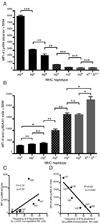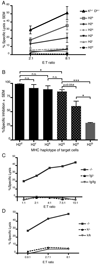Effects of MHC class I alleles on licensing of Ly49A+ NK cells
- PMID: 20194719
- PMCID: PMC2862662
- DOI: 10.4049/jimmunol.0904057
Effects of MHC class I alleles on licensing of Ly49A+ NK cells
Abstract
NK cells are innate immune lymphocytes that can react to cells lacking self-MHC class I. However, NK cells that cannot engage self-MHC through an inhibitory receptor are resistant to stimulation through their activation receptors. To become licensed (i.e., functionally competent to be triggered through its activation receptors), an NK cell must engage host MHC class I via a MHC class I-specific inhibitory receptor, such as a member of the murine Ly49 family. To explore potential determinants of NK cell licensing on a single Ly49 receptor, we have investigated the relative licensing impacts of the b, d, k, q, r, and s H2 haplotypes on Ly49A(+) NK cells. The results indicate that licensing is essentially analog but is saturated by moderate-binding MHC class I ligands. Interestingly, licensing exhibited a strong inverse correlation with a measure of cis engagement of Ly49A. Finally, licensing of Ly49A(+) NK cells was found to be less sensitive to MHC class I engagement than Ly49A-mediated effector inhibition, suggesting that licensing establishes a margin of safety against NK cell autoreactivity.
Figures





Similar articles
-
Natural killer cell licensing in mice with inducible expression of MHC class I.Proc Natl Acad Sci U S A. 2013 Nov 5;110(45):E4232-7. doi: 10.1073/pnas.1318255110. Epub 2013 Oct 21. Proc Natl Acad Sci U S A. 2013. PMID: 24145414 Free PMC article.
-
Ly49-dependent NK cell licensing and effector inhibition involve the same interaction site on MHC ligands.J Immunol. 2011 Apr 1;186(7):3911-7. doi: 10.4049/jimmunol.1004168. Epub 2011 Feb 18. J Immunol. 2011. PMID: 21335486 Free PMC article.
-
Recognition of the nonclassical MHC class I molecule H2-M3 by the receptor Ly49A regulates the licensing and activation of NK cells.Nat Immunol. 2012 Dec;13(12):1171-7. doi: 10.1038/ni.2468. Epub 2012 Nov 11. Nat Immunol. 2012. PMID: 23142773 Free PMC article.
-
MHC class I recognition by Ly49 natural killer cell receptors.Mol Immunol. 2002 May;38(14):1023-7. doi: 10.1016/s0161-5890(02)00031-7. Mol Immunol. 2002. PMID: 11955594 Review.
-
Selection, tuning, and adaptation in mouse NK cell education.Immunol Rev. 2015 Sep;267(1):167-77. doi: 10.1111/imr.12330. Immunol Rev. 2015. PMID: 26284477 Review.
Cited by
-
Ly49G, but not Ly49C/I, is dispensable for diverse antigen-specific memory NK cell responses in H-2d and H-2b mice.J Immunol. 2025 Jul 1;214(7):1802-1813. doi: 10.1093/jimmun/vkaf105. J Immunol. 2025. PMID: 40381992 Free PMC article.
-
Non-redundant ISGF3 Components Promote NK Cell Survival in an Auto-regulatory Manner during Viral Infection.Cell Rep. 2018 Aug 21;24(8):1949-1957.e6. doi: 10.1016/j.celrep.2018.07.060. Cell Rep. 2018. PMID: 30134157 Free PMC article.
-
Modulation of natural killer cell functions by interactions between 2B4 and CD48 in cis and in trans.Open Biol. 2016 May;6(5):160010. doi: 10.1098/rsob.160010. Epub 2016 May 25. Open Biol. 2016. PMID: 27249817 Free PMC article.
-
Current perspectives on natural killer cell education and tolerance: emerging roles for inhibitory receptors.Immunotargets Ther. 2015 Mar 16;4:45-53. doi: 10.2147/ITT.S61498. eCollection 2015. Immunotargets Ther. 2015. PMID: 27471711 Free PMC article. Review.
-
Natural killer cell licensing in mice with inducible expression of MHC class I.Proc Natl Acad Sci U S A. 2013 Nov 5;110(45):E4232-7. doi: 10.1073/pnas.1318255110. Epub 2013 Oct 21. Proc Natl Acad Sci U S A. 2013. PMID: 24145414 Free PMC article.
References
-
- Ljunggren HG, Karre K. In search of the 'missing self': MHC molecules and NK cell recognition. Immunol. Today. 1990;11:237–244. - PubMed
-
- Lanier LL. NK cell recognition. Annu. Rev. of Immunol. 2005;23:225–274. - PubMed
-
- Hanke T, Takizawa H, McMahon CW, Busch DH, Pamer EG, Miller JD, Altman JD, Liu Y, Cado D, Lemonnier FA, Bjorkman PJ, Raulet DH. Direct assessment of MHC class I binding by seven Ly49 inhibitory NK cell receptors. Immunity. 1999;11:67–77. - PubMed
-
- Michaelsson J, Achour A, Rolle A, Karre K. MHC class I recognition by NK receptors in the Ly49 family is strongly influenced by the beta(2)-microglobulin subunit. J. Immunol. 2001;166:7327–7334. - PubMed
-
- Tormo J, Natarajan K, Margulies DH, Mariuzza RA. Crystal structure of a lectin-like natural killer cell receptor bound to its MHC class I ligand. Nature. 1999;402:623–631. - PubMed
Publication types
MeSH terms
Substances
Grants and funding
LinkOut - more resources
Full Text Sources
Other Literature Sources
Research Materials

